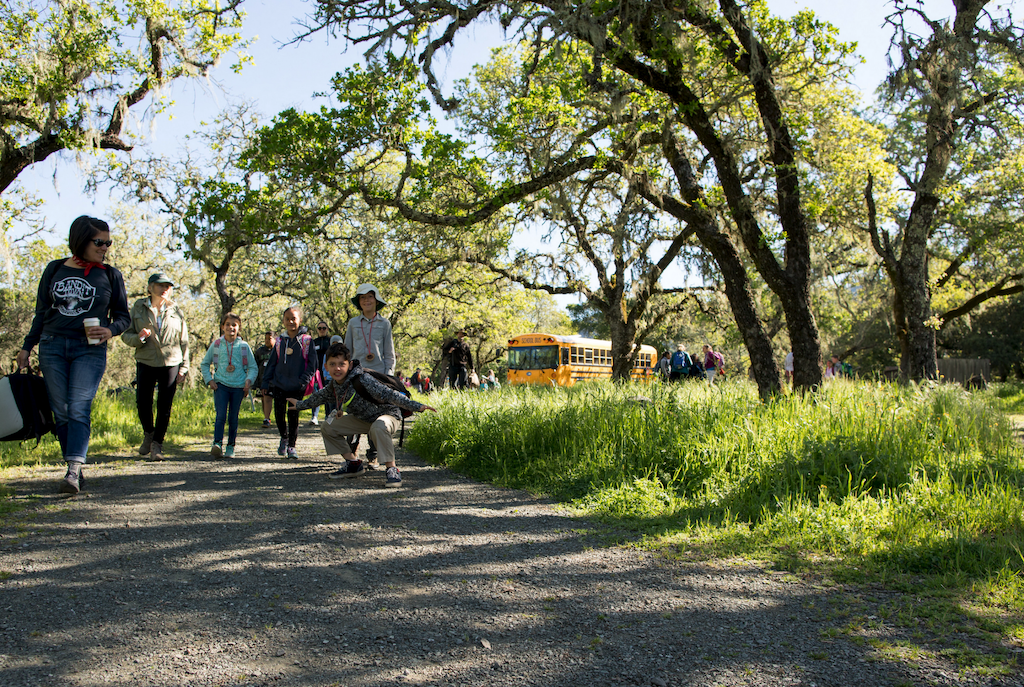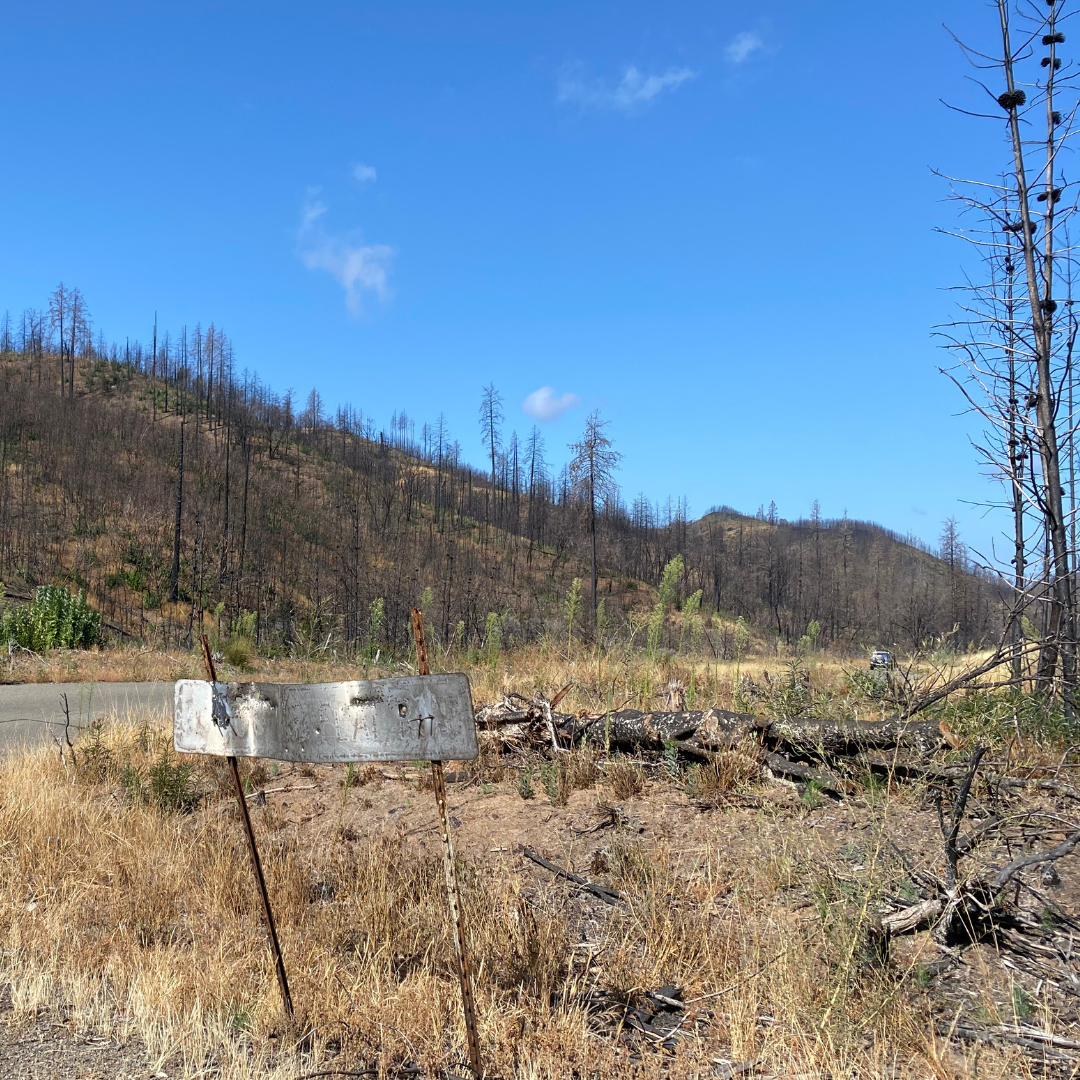In early June, our Fire Forward staff joined Modini Preserve’s Resident Biologist and Manager, Michelle Cooper, to lead a two-acre prescribed burn. The goal of this burn was to support biodiversity in an area invaded by medusahead.
California Invasive Plant Council considers this annual grass highly invasive, which is one reason that Cooper selected a medusahead-rich area for “good fire treatment.” Volunteers from the Good Fire Alliance and firefighters from Northern Sonoma County Fire District also made this burn possible.
Since the Kincade Fire in 2019, the 3,000 acres of Modini Preserve have not experienced fire—including good fire—until June of 2022. Major ecological recovery has been underway after the Kincade Fire burned 95% of the preserve. Prior to that, Modini Preserve also burned in the Calpine Fire of 2004. Fire intensity from the Kincade Fire was patchy: only some areas burned hot, leaving behind a mosaic of different aged stands across the preserve.
Species like medusahead grass are not native to the preserve; mesusahead is named for its awns or bristles that look like the mythological figure with snakes for hair.
“There are remnant patches of native grassland in non-serpentine soils at Modini Preserve, and they are threatened by invasive, annual grasses.” –Michelle Cooper
Habitat restoration in the Mayacamas Mountains extends beyond Modini Preserve
The Modini Preserve is within the ancestral territories of the Coast Miwok, Southern Pomo and Wappo peoples; we fully acknowledge that Indigenous lands are still occupied by us and others.
Currently, the Modini Preserve is protected under an Open Space conservation easement that protects 12,000 acres of contiguous habitat in the Mayacamas Mountains. The Sonoma County Agricultural Preservation and Open Space District protects open space lands of Sonoma County for future generations. ACR collaborates with this and other local organizations and agencies for management, research, and educational use of the land.
Habitat restoration remains a large part of the efforts at Modini. Many native plants thrive there, while others struggle to compete for limited resources—namely, water and sunlight. Grasses that are not native to the area, such as medusahead, present an ongoing challenge for scientists. Prescribed burns are one piece of a long-term vision to reduce the overgrowth of introduced species like medusahead and to reduce the risk of unwieldy wildfires.
Long-term plan to reduce impact of non-native medusahead grass
The grassland site targeted for prescribed fire treatment at Modini Preserve is most threatened by medusahead grass. Burning medusahead in late spring—when mature seeds are still retained in seed heads—is an effective treatment method. This method has the double benefit of killing seeds and removing thatch which should benefit the native, fire-adapted species (Kyser et al., 2014).
“Medusahead is unpalatable to wildlife and livestock, and it is also resistant to decomposition due to its high silica content,” Cooper explains on the day of the prescribed burn. “What this means is that there is a buildup of dense layers of thatch or litter. And this litter accumulation can reduce species diversity.”
Dense thatch from medusahead prevents native plants from growing in many ways (Facelli and Pickett 1991; Lamb 2008; Xiong and Nilsson 1999).
Some of the ways medusahead inhibits diverse plant growth is by:
• shading other plants from sunlight
• physically interfering with plant growth
• altering germination cues
• providing shelter for invertebrate herbivores and seed predators
• encouraging pathogens
P24 is gone and now provides a cautionary tale
In the areas west of Healdsburg, lion P24 continued to opportunistically prey on unsecured domestic animals until he was killed late last year during one such event, under a depredation permit allowed by the California Department of Fish and Wildlife (CDFW).
After so many attacks on domestic animals, it may seem justified to view P24 as an indiscriminate predator and remove the threat; however, P24’s preference for livestock is more of an anomaly than what is typically happening. We have observed that every lion moving in areas where people have unprotected pets or livestock is highly likely to kill these at some stage in its life – often on multiple occasions. Which means that removing a lion is not solving the underlying issue of needing to protect one’s animals.



Prescribed burn at Modini Preserve delivers “an incredible experience”
Prior to the prescribed burn at Modini Preserve’s Land Steward, Tomas Ruiz, mowed the area to ensure adequate fuel breaks. Additionally, Modini Preserve’s Resource Ecologist Julianne Bradbury assisted in pre-treatment data collection.
At first, Cooper was nervous about how this prescribed fire at Modini Preserve would go. She had to evacuate her home during the Kincade Fire in 2019, but this two-acre prescribed burn felt different—safer, smaller, and intentional.
“My feeling of unease was gone about five minutes after they started the fire,” Cooper says. “It was clear that the team with Fire Forward had it totally under control. Overall, this has been an incredible experience.”
It will be exciting to see how this area looks one month, let alone one year, from now. Prior to the burn, scientists and stewards at Modini Preserve measured species richness and percentage of cover. They will continue to monitor for species richness and signs of erosion, especially after significant rain events.
References
Facelli, José M., and Steward TA Pickett. “Plant litter: its dynamics and effects on plant community structure.” The botanical review 57.1 (1991): 1-32.
Hilton, R. P., & Mederois, J. (2018, December). Serpentine. Journal of the Sierra College Natural History Museum. Retrieved June 14, 2022, from https://www.sierracollege.edu/ejournals/jscnhm/v6n2/
serpentine.html
Lamb, Eric G., et al. “When Competition Does Not Matter: Grassland Diversity and Community Composition.” The American Naturalist, vol. 171, no. 6, 2008, pp. 777–87, https://doi.org/10.1086/587528. Accessed 22 Apr. 2022.
Xiong, Shaojun, and Christer Nilsson. “The Effects of Plant Litter on Vegetation: A Meta-Analysis.” Journal of Ecology, vol. 87, no. 6, 1999, pp. 984–94, http://www.jstor.org/stable/2648387. Accessed 22 Apr. 2022.




